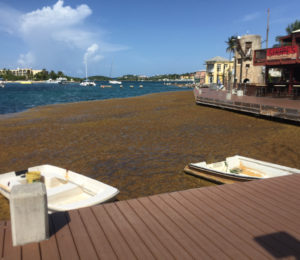
This summer’s influx of sargassum seaweed is threatening to overwhelm the Bovoni landfill and has prompted government agencies to search for another way to manage its disposal.
A Waste Management Authority spokesperson Friday denied a report that the agency is about to stop accepting sargassum at the St. Thomas landfill, but said it recognizes the continuing volume of seaweed drifting into V.I. waters and that the rotting on its shorelines is a serious problem.
“It has to be addressed,” said Charmin Springer, Waste Management’s acting communications manager and environmental educator. It is an issue throughout the territory but is worse on St. Thomas than St. Croix.
She said representatives of several government agencies met Aug. 8 to discuss the situation and expect to continue “working as a team.” She would not say whether temporarily closing the landfill to sargassum is an option but said Waste Management and the Department of Planning and Natural Resources will issue a joint press release soon.
DPNR and Waste Management were two of the agencies represented at the meeting, she said. The others were VITEMA – Virgin Islands Territorial Emergency Management Agency, which acted as its host, along with the University of the Virgin Islands and the departments of Tourism, Public Works, Property and Procurement, and Agriculture.
Areas throughout the Caribbean and up to Florida have been struggling with an overabundance of algae each summer since 2011. Mexico’s Caribbean coast has been particularly hard-hit. The country has spent millions of dollars trying to protect its tourism industry as the seaweed tangles swimmers and snorkelers and fouls beaches.
Scientists are warning of actual and potential environmental damage that includes the degradation of seagrass beds, damage to coral reefs and the depletion of a wide-range of fish and marine life. They are still studying why sargassum has transformed from a centuries-old phenomenon that was a healthy part of the ocean’s ecosystem into a monster disrupter.
High among the suspected causes is a spike in the nutrients that feed sargassum, supplied largely by man-made run-off, including ground fertilizers released into the sea via the Amazon River.
Whatever the causes, rather than the occasional floating “raft” of seaweed driven by winds and currents that might appear on the horizon a few times each summer, islands are now dealing with great masses of the algae intermittently washing up on shorelines. As it dries, it emits a sulfurous malodor and can become toxic.
“It’s very unpredictable,” said James Boschulte, president of Boschulte Landscaping, whose crews often interrupt landscaping work to rake up sargassum from St. Thomas beaches. “It comes and goes. Some days there’s nothing. Some days we spend all day on clean-up. When it’s really bad, it piles up really quick.”
He said “from time to time” government officials say they can’t take more seaweed for a short time, but the landfill remains open.
Rodney Renner, chairman of the V.I. Hotel and Tourism Association (and general manager of Margaritaville Vacation Club Resort) said the seaweed is a major problem for the territory’s hotels and a very expensive one.
“During periods of large sargassum blooms, any beach impacted can collect as many as 40 open-top bins to be taken to the landfill,” Renner said in an email to the Source. “Delay in removal allows the algae to decompose on the beach causing a toxic environment both in the water and on shore. Months with a large amount of sargassum can cost an individual property over $60,000 for removal in addition to compensation (to guests) for the inconvenience.
“Research continues to determine ways to mitigate the impact of sargassum. The use of booms to deflect or redirect the algae has some success but (they can) get overwhelmed during periods of large blooms. Collection by boat to prevent it from getting to the beach can be effective but is costly at the beginning seasonal cost of $500,000 and, as with booms, can’t handle large quantities fast enough,” Renner said.
“One of the unique challenges of sargassum is that, at this time, there are no immediate uses for it,” he continued. “With only a few days before the decaying algae begins to smell, excess has to be disposed of quickly with the landfill being the only option for many properties.”
Throughout the region, research is ongoing to find practical uses for sargassum. The most obvious might seem to be as fertilizer. Benjamin Schwartz, owner of Playland Marine, removes the seaweed from shallow waters off St. Thomas before it hits the shore and said he gives it all away to Bordeaux farmers, but that is after it has been washed and before it can deteriorate into toxicity.
None of the sargassum he removes goes to the already stretched Bovoni landfill or what he jokingly calls “Mount St. Thomas,” Schwartz said.
But that is where other haulers – including Public Works – take what they collect from land.
“There’s nowhere else to take it,” Boschulte said. If the landfill becomes inundated and inaccessible for sargassum, “We’re going to have to find an alternate solution because it’s not going to stop.”
Typically, the large blooms die out in early fall, but they return the following spring. With the exception of 2013, the territory has been swamped by sargassum every summer since 2011, and the prevailing opinion in the scientific community is that massive blooms will continue to plague the region annually for the foreseeable future.





